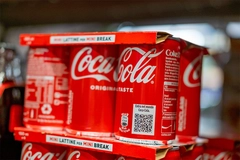Irish Food & Drink Key Export Driver as Sales Approach €8 Billion
The expansion in food and drink exports outpaced the increase in total merchandise exports and is estimated to have accounted for almost one-third of total growth during the first nine months of 2010.

1/13/2011 --- Irish food and drink was a major contributor to the economy’s strong export performance in 2010, with export sales expanding by 11 per cent to reach €7.9 billion, according to Bord Bia. The increase, amounting to just over €800 million, was supported by a more stable consumer environment, reduced exchange rate pressures, and improved relative competitiveness. It was also boosted by rising global prices for most agricultural commodities. The expansion in food and drink exports outpaced the increase in total merchandise exports and is estimated to have accounted for almost one-third of total growth during the first nine months of 2010.
“The strength of the industry’s export performance is all the more commendable for the fact that it has been achieved in what remains a highly competitive marketing environment” according to Dan Browne, Chairman of Bord Bia. “All major categories recorded increases, led by dairy, which jumped by more than €300 million or 17 per cent. Meat and livestock exports were almost €200 million higher while beverage and prepared food exports recorded growth of €130 million and €100 million respectively.”
“The success of the industry in growing its penetration of Continental EU markets is also to be welcomed”, according to Mr.Browne, “with exports to the mainly eurozone markets increasing by 14 per cent.” Continental EU markets now account for 34 per cent of the industry’s total exports of food and drink.
The economy continues to dominate consumer thinking and behaviour throughout many key European markets, where more consumers believe their purchasing power will decrease than increase over the coming two years. The results of the fourth wave of Bord Bia’s Feeling the Pinch survey, completed in late 2010, also shows a high degree of uncertainty remains among Irish and British consumers. Indeed, the only certainty that appears to be emerging is that significant change is unlikely to materialise in 2011 and as the search for value continues, consumers are embracing the “new normal”.
Nevertheless, looking ahead to 2011 the prospects for Irish food and drink exports remain positive, helped by strong global demand for commodity products and a relatively tight supply situation in a number of key product categories. “In a year in which the world’s population will reach seven billion, growth in global demand is set to underpin food markets well into the future, albeit with some volatility to be expected”, according to Aidan Cotter, Chief Executive of Bord Bia. He added that “the challenge for the Irish food and drink industry is to maintain its current momentum, particularly in the areas of cost competitiveness, innovation and marketing. Implementation of the recommendations of Food Harvest 2020* (incorporating Bord Bia’s Pathways for Growth), which reflect a consensus industry view for supporting growth, will be critical to sustaining this momentum and delivering on its ambitious targets in the decade ahead”, he said.
Irish food and drink manufacturers across all categories are more optimistic and showing a more positive outlook, according to Bord Bia’s recent food industry survey (December 2010). In total, 70 per cent of exporters involved in the survey viewed the prospects for their business in 2011 as good or very good. When asked to compare their prospects to a year earlier, 56 per cent rated them as better.
In terms of sales prospects, 64 per cent of exporters had increased their sales forecasts for 2011. When asked the source of new business generated over the last year some 76 per cent increased business with existing customers, 34 per cent won back business with former customers, while 18 per cent developed business with new customers.
Employment levels have generally held up well, although figures vary by sector. More than one fifth of respondents have increased full time staff numbers over the last year, with a further 61 per cent maintaining employment levels.
Respondents also highlighted a number of key challenges facing their business including the value of the euro against the pound; pressure on consumer spending; changes in purchasing behaviour; and competition between retailers. The reaction by manufacturers to these challenges has focused on cost control, efficiencies and a review of their customer portfolio which has seen more than half of respondents increase their expenditure on business development over the last year. These measures may also be seen in the context of the difficulty cited by 75 per cent of respondents of securing price increases even as ingredient costs rise. Critically it highlights the need for continuous innovation as consumers embrace the ‘new normal’ in their search for value. Some 62 per cent of respondents listed changing consumer purchasing behaviour with a focus on value for money as a key challenge for industry.
As a consequence, Irish exporters now appear to be in a better position to deal with the ongoing movements in exchange rates. The results of the survey suggest that 82 per cent could sustain an exchange rate with the pound at 1€ = 85p in the long run with 62 per cent able to sustain their business if the rate was between 85p and £1.
Finally, the current strength of global food markets is providing a benign backdrop for the industry, particularly for the primary sectors. The FAO food price index reached an all-time high in December at 215 points, slightly higher than the previous peak in 2008 but as much as 25% higher than in December, 2009 and more than double its level, at 90 points, in 2000. Looking ahead, the growth in world food prices is expected to remain high by historical standards while varying across commodities, with the strongest growth expected in cereals. Ireland’s grass-based livestock production systems should be well positioned to cope with these price pressures (from an input perspective) and even improve relative competitiveness.
















